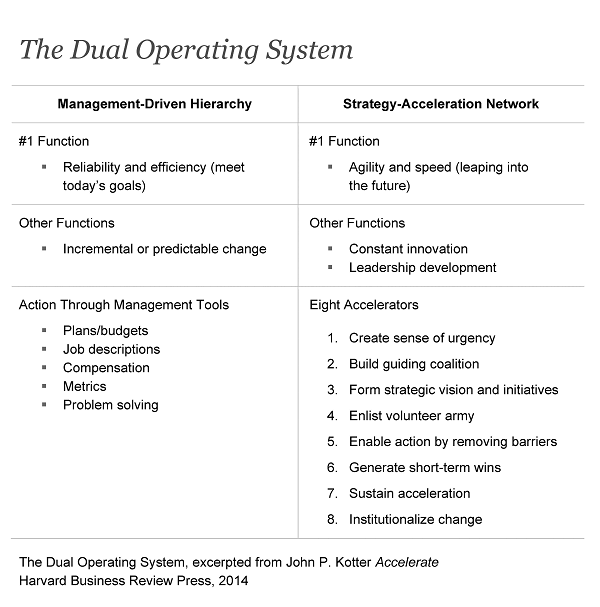What do you read to lead?
This is the third installment in an occasional series of book reviews by David La Piana, highlighting books that are likely to be outside the nonprofit leader’s normal reading list but offer useful insights.
 Harvard Business School professor John P. Kotter is best known for his eight-step guide to navigating organizational change, expressed in 19 books and dozens of articles. His latest book, Accelerate, builds on the eight-step approach but introduces a whole new concept, one which I think has broad applicability to the nonprofit sector. Here’s the skinny.
Harvard Business School professor John P. Kotter is best known for his eight-step guide to navigating organizational change, expressed in 19 books and dozens of articles. His latest book, Accelerate, builds on the eight-step approach but introduces a whole new concept, one which I think has broad applicability to the nonprofit sector. Here’s the skinny.
Kotter posits that the modern organization, be it corporate, nonprofit, or governmental, is optimized for current performance, not innovation. Young organizations start off consumed with innovation, entrepreneurship, and growth. But as they succeed over time, they necessarily evolve and fine-tune a system to deliver on today’s commitments. This system enables the organization to reliably meet current performance targets, maintain financial control, and operate increasingly complex programs that create real value. The problem is that this system, which Kotter calls “The Management Hierarchy,” is also charged with anticipating and navigating change. When the required change is incremental – say, a need to open a facility in a new location – the hierarchy sees it and adjusts. However, in our increasingly turbulent and disrupted world the magnitude of the challenges, and thus the scale of the needed change, are often so big that the hierarchy cannot even perceive, let alone manage, them.
What is an organization to do? If, as Kotter argues, the very system organizations require to operate effectively (the hierarchy) is necessarily narrowly focused on today’s performance, rendering it ill-equipped to anticipate and manage the kind of game-changing disruption we are seeing regularly across all sectors, how do we stay ahead of the curve? Kotter has developed an answer he calls “The Dual Operating System.” This new system pairs the hierarchy with a non-hierarchical “Strategy Acceleration Network” staffed solely by volunteers (in this usage, self-selected participants, not unpaid volunteers) from throughout the organization. While closely connected to organizational leadership and the hierarchy, the network maintains a fair degree of independence. The figure below recreates Kotter’s model.

As you can see, the hierarchy (left) is optimized for reliability and efficiency, enabling it to manage both current performance and incremental change. Its tools include the standard management tool box. What’s new is the network (right), which is optimized for agility, speed, and constant innovation. As a result of its role, and of the fact that it is performed by people from all levels of the organization, the network also functions quite well as a leadership incubator. Those familiar with Kotter’s eight-step model for change will recognize its adaptation in The Eight Accelerators characterizing the network.
Kotter recounts cases where the Dual Operating System has helped an organization to succeed beyond anyone’s wildest dreams. Having read many management books, all of which are crammed with these tales of outsize success, I take the general applicability of these cases with a large grain of salt. Nonetheless, Kotter’s basic insight and premise make very good sense. Having built an organization that lives and breathes daily, monthly, and annual performance, it is unreasonable to also expect it to see around corners to anticipate future strategic challenges.
In the nonprofit context, let’s briefly apply this thinking to the successful human service organization. It is subject to government contracting and philanthropic funding requirements, a quality control regimen, the dictates of a board of directors, and specific legal and professional licensure strictures. As the organization grows to meet these challenges while delivering high-quality services to an ever-growing clientele, fundamental demographic, technological, financing, and political changes are taking place in its market. By the time the hierarchy sees, digests, and reacts to these changes it may be too late. Would a volunteer group assembled from all parts and levels of the organization, and tasked, broadly, with tracking strategic challenges and accelerating innovative responses, do a better job? I think it might.
See Accelerate: Building Strategic Agility for a Faster-Moving World, by John P. Kotter, Harvard Business School Press, 2014
To learn more about the Dual Operating System model, visit Kotter International.


Comment section